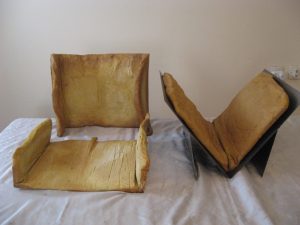The Temple
Research into the Temple has been gaining momentum in the academic world in recent years, alongside the activities of the Ne’emanei HaMikdash [Temple Faithful] movement.. Our research deals with the realia of the religious ritual in the field of material culture, in light of the historical reality at the end of the Second Temple period, according to Jewish sources and classical literature. Examples of this are the identification of the spices used in the Temple incense, the stones of the priestly breastplate and their origins, a possible replication of the lehem hapanim [shew-bread] and precious dyes that were in the temple: tekhelet, argaman, and tola’at shani.

Replication of the Temple shew-bread
An innovative study was conducted in an attempt to assess the scope of the Temple’s economic activity throughout the year, for example, the number of sacrifices brought by the public and by individuals, the quantities of fine flour and oil for used offerings and wine for libations, incense, salt, and wood for burning on the altar. The study also dealt with the question of how Jerusalem deployed to absorb masses of pilgrims in terms of lodging, drink, the ecology of a Temple city, coping with sanitation, and more.
